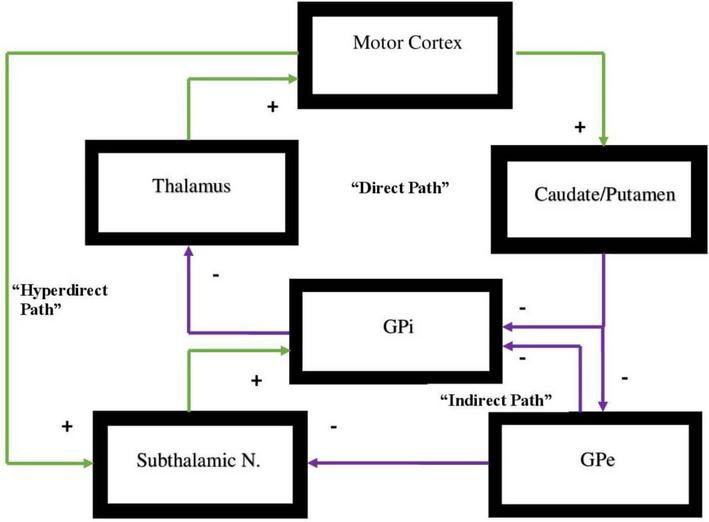FIGURE 1.

Representation of the direct vs. indirect pathways of the basal ganglia indicating facilitatory vs. inhibitory components of motor activity. In the direct pathway, Input from the cerebral cortex to the striatum is associated with triggering of inhibitory neurons in the striatum. This subsequently is associated with increased inhibitory output projecting to the globus pallidus-internal [GPi]. Subsequently, decreased inhibitory output from GPi to the ventral anterior [VA] and ventral lateral [VL] nuclei of the thalamus is evidenced that in turn projects through excitatory pathways to the premotor cortex. The direct pathway regulates motor and premotor cortical excitation that is involved in planning and movement initiation. The indirect pathway, when appropriately functioning, should inhibit movement when cortically generated excitatory activity enables inhibitory neurons in globus pallidus external [GPe]. These subsequently inhibit tonic inhibitory output neurons associated with decreased tonic inhibition of the subthalamic nucleus [STN]. The result is increased excitatory output to GPi. Excitatory input to GPi adds inhibitory output from GPi to the thalamus which, in turn, decreases excitatory feedback to cerebral cortex. The result, under normal circumstances, should lead to the inhibition of motor activity. Dopamine supports the activity of the direct pathway suppressing activity of indirect pathway. The hyperdirect pathway is exceptional as it circumvents the striatum with a direct link from the cortex to the subthalamic nucleus, then directing excitatory projections to the GPi. The hyperdirect pathway is key for containing non-purposeful movement. When the system is impaired, individuals are less able to inhibit unplanned motor activity.
